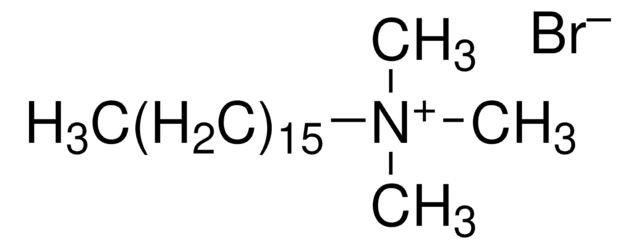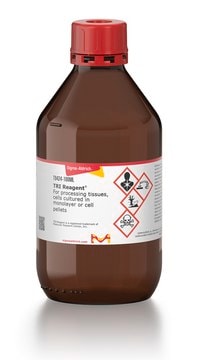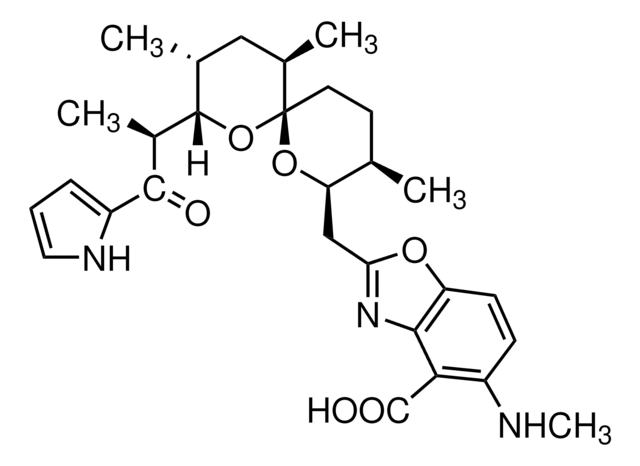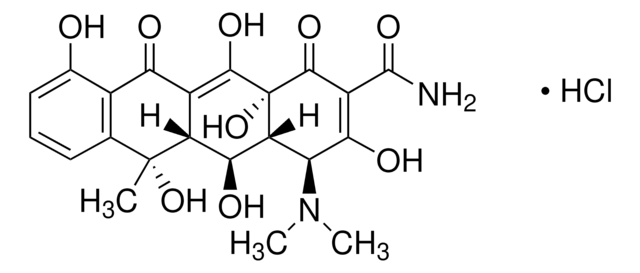R5628
Hae III from Haemophilus aegyptius
Restriction Enzyme
Faça loginpara ver os preços organizacionais e de contrato
About This Item
Número CAS:
Número MDL:
Código UNSPSC:
12352204
Produtos recomendados
grau
for molecular biology
forma
buffered aqueous glycerol solution
concentração
10,000 units/mL
Condições de expedição
wet ice
temperatura de armazenamento
−20°C
Procurando produtos similares? Visita Guia de comparação de produtos
Especificidade
Recognition sequence: 5′-GG/CC-3′
Ligation and recutting results: After 2-10-fold Hae III overdigestion of 1 μg λ DNA substrate, results in 100% cutting, >50% of fragments can be ligated, and >95% recut.
Heat inactivation: 80 °C for 20 minutes.
Ligation and recutting results: After 2-10-fold Hae III overdigestion of 1 μg λ DNA substrate, results in 100% cutting, >50% of fragments can be ligated, and >95% recut.
Heat inactivation: 80 °C for 20 minutes.
Aplicação
HaeIII is a restriction enzyme that is used in molecular biology methods to cleave DNA at the recognition site 5′-GG/CC-3′ to generate DNA fragments with blunt termini.
Outras notas
Supplied with 10x Restriction Enzyme Buffer SM (B3158).
Comment: Inefficient for single-stranded DNA cleavage.
Hae III requires optimal reaction conditions in order to avoid star activity.
Hae III requires optimal reaction conditions in order to avoid star activity.
forma física
Solution in 20 mM Tris-HCl, pH 7.7, 0.1 mM EDTA, 400 mM NaCl, 10 mM 2-mercaptoethanol, 50% glycerol (v/v) at 4°C
produto relacionado
Código de classe de armazenamento
10 - Combustible liquids
Classe de risco de água (WGK)
WGK 2
Ponto de fulgor (°F)
Not applicable
Ponto de fulgor (°C)
Not applicable
Certificados de análise (COA)
Busque Certificados de análise (COA) digitando o Número do Lote do produto. Os números de lote e remessa podem ser encontrados no rótulo de um produto após a palavra “Lot” ou “Batch”.
Já possui este produto?
Encontre a documentação dos produtos que você adquiriu recentemente na biblioteca de documentos.
Stefano Fazi et al.
Environmental microbiology, 10(10), 2760-2772 (2008-07-23)
We studied the diversity, community composition and activity of the primary microbial colonizers of the water above freshly re-wetted sediments from a temporary river. Dried sediments, collected from Mulargia River (Sardinia, Italy), were covered with sterile freshwater in triplicate microcosms
Duplex regions in "single-stranded" phiX174 DNA are cleaved by a restriction endonuclease from Haemophilus aegyptius.
R W Blakesley et al.
The Journal of biological chemistry, 252(20), 7300-7306 (1977-10-25)
Beatrix Kotlan et al.
Journal of immunology (Baltimore, Md. : 1950), 175(4), 2278-2285 (2005-08-06)
The potential tumor-recognizing capacity of B cells infiltrating human breast carcinoma is an important aspect of breast cancer biology. As an experimental system, we used human medullary breast carcinoma because of its heavy B lymphocytic infiltration paralleled to a relatively
C Kessler et al.
Gene, 92(1-2), 1-248 (1990-08-16)
The properties and sources of all known class-I, class-II and class-III restriction endonucleases (ENases) and DNA modification methyltransferases (MTases) are listed and newly subclassified according to their sequence specificity. In addition, the enzymes are distinguished in a novel manner according
Cong Zhu et al.
Nucleic acids research, 41(4), 2455-2465 (2013-01-11)
Zinc-finger nucleases (ZFNs) have been used for genome engineering in a wide variety of organisms; however, it remains challenging to design effective ZFNs for many genomic sequences using publicly available zinc-finger modules. This limitation is in part because of potential
Nossa equipe de cientistas tem experiência em todas as áreas de pesquisa, incluindo Life Sciences, ciência de materiais, síntese química, cromatografia, química analítica e muitas outras.
Entre em contato com a assistência técnica






